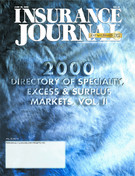The motives for buying an aircraft are as varied as the uses to which the aircraft can be applied—as are, of course, the risks associated those uses.
Some underwriting companies also insure an array of aviation-related entities, such as parts manufacturers, fixed based operators, and small airports.
As such, most people seeking aviation coverages will need policies customized to their own needs. However, there are occurring changes within the aviation insurance market, especially over the past year, which could affect how easily coverages can be obtained.
“For at least the last 15 years, it’s been a fairly soft market, just like the rest of the business,” said Connie French, an aviation broker for the Kentucky branch of Indianapolis-based Arlington/Roe & Co. Inc. “But now we are starting to see prices going up anywhere from five to 25 percent, depending on the type of risk.” French added that these rate hikes are somewhat more evident for commercial business risks than for typical pleasure and business type risks.
In addition, as a result of adverse experience, some carriers have actually pulled out of certain classes of business or reduced limits of liability. “We’re starting to see the companies cut back on the limits they want to offer,” French said. “It wasn’t a problem in the past to get limits of $5 million [or] $10 million on personally owned pleasure and business type aircraft. Now the companies have cut back on the limits they want to offer. A lot of them don’t want to go higher than $2 million, as opposed to the 5 or 10 they used to offer.”
Chester Zalesski, president of Response Aviation Insurance Services in Glendale, Calif., agreed: “In rare cases you can get higher limits…[but] each carrier has suffered adverse loss underwriting,” he said.
“One thing that we do have available now, which has not really been of much use to us in the past, is an excess market for liability,” French said. “That’s going to help out the fact that the companies have cut back on the limits, so we could still provide an excess policy to people that want higher limits.”
However, Zalesski expressed the opinion that use of excess coverages can be very restrictive. “Many of the excess underwriters, especially in California, do not want to drop down below a certain level because of the litigation that’s been involved over the years,” he said.
Those familiar with the aviation market also point to significant consolidation and merger activity in the marketplace as a major contributing factor to the current hardening in that area.
“Over the last couple of years, there have been a lot of mergers and acquisitions taking place,” said Don Grondin, owner of PIK West Insurance Agency in Simi Valley and vice president of the Aviation Insurance Association (AIA). “As a matter of fact, Houston Casualty went out and bought and merged five different small aviation companies all under one roof. Consequently the market has diminished significantly. It’s impacted the small aviation flyer significantly because there are not as many markets to solicit for a [quote].”
Grondin also noted that while there may have been approximately 18 aviation insurance companies in past years, that number has dropped down to maybe seven or eight aviation markets, and all of these just want to write “the cream of the crop.”
“It used to be that companies would have their own little niche, and they would really be aggressive in that niche,” Grondin explained. “It seems now they’re all the same. They’re always trying to improve their bottom line and make a profit for their stockholders. Obviously, there’s nothing wrong with that. But along those lines, some of the client base [e.g. schools and repair facilities, maintenance shops] have really taken a hit…There are some that are just closing their doors because they can’t afford to continue at the rates that are presented to them.”
In terms of underwriting considerations, French underlined the fact one can never compare two different aircraft policies because there is so much to consider when quoting: the pilot, experience level, type of aircraft, and use of the airplane all come into play.
“If you’re talking an aircraft policy, you always have to have information on the person that’s flying the aircraft-their overall experience and then experience specific to the aircraft they’re buying,” French said. “If it’s a single-engine aircraft, you don’t need as much information, but when you get into the larger multi-engine aircraft or turbo prop or jet aircraft, it gets a whole lot more complicated.”
French said that companies will write older, or antique, aircraft, as long as the aircraft is maintained according to Federal Aviation Administration (FAA) standards. “It’s mainly the pilot,” she said. “The policy states that the aircraft has to have an airworthiness certificate, and the pilot has to have a valid license. In order to have a license you have to have a current medical and a current biennial flight review. As long as all those are met, then they really don’t go into what kind of shape the aircraft is in. [But] people generally tend to take pretty good care of their airplanes.
“If we get a call for something, we’ll try to write it,” French continued, adding that they even write people that participate in or sponsor air shows. “[But] now that the market’s starting to tighten up, there are certain risks that companies just will not quote on. Especially if a person’s buying an aircraft that they’re not qualified to fly.”
And just because it goes up in the air does not mean it is governed by the FAA. If it is not governed by the FAA, it will not meet the criteria of an aircraft under many reinsurance treaties. This includes certain types of ultra-light aircraft as well as powered parachutes, for which, French stated, one is not required to a have a pilot’s license to operate. “They aren’t governed by the FAA regulations,” she said. “The aviation market doesn’t consider them an aviation exposure.”
“As far as I know, there isn’t anything available for them,” Zalesski added. “The manufacturers sometimes claim they have [coverages]. With what we have found in the past, there are things that are placed with perhaps non-regulated insurance companies or obscure insurance companies.”
When asked to give a prediction as to where the market will go from here, James A. Roe, president of Arlington/Roe & Co., took a broad view. “The property/casualty market, in general, is going to see some hardening,” he said. “[With] aviation being part of the p/c market, there are going to be some capacity demands, so there probably won’t be as much capacity offered in the next couple of years, which means prices are going to go up.
“From the producer’s perspective, in terms of opportunities to maximize our revenues, it’s a good thing because for the same risk, we’ll be getting more money and commission revenues will go up,” Roe continued. “From the buyer’s perspective it’s a bad thing because the price of their insurance will now go up…The return on investment hasn’t been as good as [insurance companies] need to continue to attract capital, so they have to re-underwrite some of their business. They have to get tighter with their underwriting criteria, and the prices have to go up. Depending on what the insured is buying, they may have a combination of both: underwriting restrictions and price increases…It also means on behalf of the producer community, it’ll be tougher to find the right insurer.”
“Where there’s a need, someone will eventually fill that need,” Grondin concluded. “It simply has to come to a price level where companies feel they can get in and make it profitable for them to write that class of business. Right now, perhaps, it hasn’t reached that level where the major players are willing to jump in and participate. Once that premium level is reached, I think you’ll find some other companies willing to jump in.”
Was this article valuable?
Here are more articles you may enjoy.


 ‘Great Resignation’ Enters Third Year as Workers Embrace AI, Upskilling, PwC Says
‘Great Resignation’ Enters Third Year as Workers Embrace AI, Upskilling, PwC Says  Guidance and Insurance Implications for the CDK Global Cyberattack
Guidance and Insurance Implications for the CDK Global Cyberattack  Farmers Adjusters Cry Foul Over Workloads, Claims Handling in Letter to Regulators
Farmers Adjusters Cry Foul Over Workloads, Claims Handling in Letter to Regulators  State Farm Seeking Large Rate Increases in Wildfire-Prone California
State Farm Seeking Large Rate Increases in Wildfire-Prone California 


